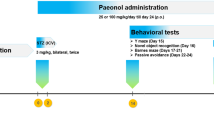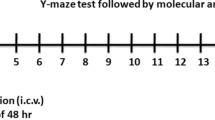Abstract
Diabetes mellitus (DM) is a risk factor for Alzheimer’s disease (AD), and several individuals with AD are diabetic. Most non-transgenic animal models of AD make use of oral treatment with aluminium chloride (AlCl3) to induce brain lesions pathognomonic of the disease. Moreover, streptozotocin (STZ) can induce pathological features of either AD or DM depending on the mode of treatment. In the present study, we characterised prefrontal microanatomy and antioxidant defence system in a rat model of AD confounded by DM, with the objective of assessing the suitability of this model in the study of sporadic AD with DM co-morbidity. Adult Wistar rats were randomly assigned to receive either intraperitoneal STZ (30 mg/kg/day for 3 days; to induce DM), oral AlCl3 (500 mg/kg/day for 4 weeks; to induce some brain lesions characteristic of AD); or both STZ and AlCl3 (to induce AD with DM co-morbidity). Untreated rats served as controls. During treatment, blood glucose levels and body weights were evaluated repeatedly in all rats. At euthanasia, prefrontal cortex was homogenized in phosphate buffer solution and the supernatants assayed for some antioxidant enzymes (catalase, CAT; superoxide dismutase, SOD; and reduced glutathione, GSH). Moreover, following perfusion-fixation of the brain, frontal lobes were processed by the haematoxylin and eosin (H&E) or Congo red technique. Our findings showed that in rats co-administered AlCl3 and STZ (AD + DM rats), prefrontal levels of GSH reduced significantly (p < 0.05), while reductions in SOD and CAT were not significant (p > 0.05) compared with the controls. Moreover, in this model of AD with DM co-morbidity, extensive neuronal cell loss was observed in the prefrontal cortex, but Congophilic deposits were not present. The neurodegenerative lesions and antioxidant deficits characteristic of this AlCl3 + STZ (AD + DM) rat model were more pronounced than similar lesions associated with mono-treatment with either STZ (DM) or AlCl3 (AD) alone; and this makes the AlCl3 + STZ model a suitable option for the study of neurodegenerative diseases (such as AD) with DM co-morbidity.




Similar content being viewed by others
References
Adeghate E, Donath T, Adem A (2013) Alzheimer disease and diabetes mellitus: do they have anything in common? Curr Alzheimer Res 10:609–617
Aebi H (1984) Catalase in vitro. Methods Enzymol 105:121–126
Ahmad W (2013) Overlapped metabolic and therapeutic links between alzheimer and diabetes. Mol Neurobiol 47:399–424
Akerboom TP, Sies H (1981) Assay of glutathione, glutathione disulphide and glutathione mixed disulphides in biological samples. Methods Enzymol 77:373–382
Akinola OB, Omotoso GO, Dosumu OO, Akinola OS, Olotufore F (2011) Diabetes-induced prefrontal nissl substance deficit and the effects of neem-bitter leaf extract treatment. Int J Morphol 29:850–856
Bancroft J, Stevens A (1982) Theory and practice of histological techniques, 2nd edn. Churchill Livingston, New York, p 131–135
Brun A (1987) Frontal lobe degeneration of non-alzheimer type I neuropathology. Arch Gerontol Geriatr 6:193–208
Butterfield DA, Di Domenico F, Barone E (2014) Elevated risk of type 2 diabetes for development of Alzheimer disease: a key role for oxidative stress in brain. Biochim Biophys Acta 1842(9):1693–1706
Chen S, Liu AR, An FM, Yao WB, Gao XD (2012) Amelioration of neurodegenerative changes in cellular and rat models of diabetes-related Alzheimer's disease by exendin-4. Age 34:1211–1224
Chen S, Fan C, Chiue M, Chou C, Chen J, Hseu R (2013) Hemodynamic and neuropathological analysis in rats with aluminum trichloride-induced alzheimer’s disease. PLoS One 8:e82561.
Cheng D, Noble J, Tang MX, Schupf N, Mayeux R, Luchsinger JA (2011) Type 2 diabetes and late-onset Alzheimer's disease. Dement Geriatr Cogn Disord 31:424–430
Correia SC, Santos RX, Carvalho C, Cardoso S, Candeias E, Santos MS, Oliveira CR, Moreira PI (2012) Insulin signaling, glucose metabolism and mitochondria: major players in Alzheimer's disease and diabetes interrelation. Brain Res 2:64–78
De Felice FG, Ferreira ST (2014) Inflammation, defective insulin signaling, and mitochondrial dysfunction as common molecular denominators connecting type 2 diabetes to Alzheimer disease. Diabetes 63:2262–2272
de la Monte SM (2012) Contributions of brain insulin resistance and deficiency in amyloid-related neurodegeneration in Alzheimer's disease. Drugs 72:49–66
Do Carmo S, Cuello AC (2013) Modeling Alzheimer's disease in transgenic rats. Mol Neurodegener 8:1750–1326
Du LL, Chai DM, Zhao LN, Li XH, Zhang FC, Zhang HB, Liu LB, Wu K, Liu R, Wang JZ, Zhou XW (2014) AMPK activation ameliorates Alzheimer's disease-like pathology and spatial memory impairment in a streptozotocin-induced Alzheimer's disease model in rats. J Alzheimers Dis 43(3):775–784
Ferreira ST, Clarke JR, Bomfim TR, De Felice FG (2014) Inflammation, defective insulin signaling, and neuronal dysfunction in Alzheimer's disease. Alzheimers Dement 10:010
Gong Q, Wu Q, Huang X, Sun A, Shi J (2005) Protective effects of Ginkgo biloba leaf extract on aluminium-induced barin dysfunction in rats. Life Sci 77:140–148
Holscher C (2011) Diabetes as a risk factor for Alzheimer's disease: insulin signalling impairment in the brain as an alternative model of Alzheimer's disease. Biochem Soc Trans 39:891–897
Khan MB, Khan MM, Khan A, Ahmed ME, Ishrat T, Tabassum R, Vaibhav K, Ahmad A, Islam F (2012) Naringenin ameliorates Alzheimer's disease (AD)-type neurodegeneration with cognitive impairement (AD-TNDCI) caused by the intracerebroventricular streptozotocin in rat model. Neurochem Int 61:1081–1093
Khan MB, Ahmad M, Ahmad S, Ishrat T, Vaibhav K, Khuwaja G, Islam F (2015) Bacopa monniera ameliorates cognitve impairement and neurodegeration induced by intracerebroventricular streptozotocin in rat: behavioral, biochemical, immunohistochemical and histopathological evidences. Metab Brain Dis 30:115–127
Kim D, Jung S, Kim T, Lee K, Kim K (2015) Treadmill exercise decreases incidence of alzheimer’s disease by suppressing glycogen synthase kinase-3β expression in streptozotocin-induced diabetic rats. J Exer Rehab 11:87–94
Lenzen S (2008) The mechanism of alloxan- and streptozotocin-induced diabetes. Diabetologia 51:216–226
Li Z, Zhang W, Sima AF (2007) Alzheimer-like changes in rat models of spontaneous diabetes. Diabetes 56:1817–1824
Ott A, Stolk RP, van Harskamp F, Pols HA, Hofman A, Breteler MM (1999) Diabetes mellitus and the risk of dementia: the rotterdam study. Neurobiologia 53:1937–1942
Paoletti F, Aldinucci D, Mocali A, Caparrini A (1986) A sensitive spectrophotometric method for the determination of superoxide dismutase activity in tissue extract. Anal Biochem 152:536–554
Prince M, Jackson J (2009) Alzheimer’s disease International world Alzheimer report 2009. In. London
Reddy VP, Zhu X, Perry G, Smith MA (2009) Oxidative stress in diabetes and alzheimer's disease. J Alzheimers Dis 16:763–774
Stevanovic LD, Jovanovic MD, Jelenkovic A, Colic M, Stojanovic I, Ninkovic M (2008) The effect of 7-nitroindazole on aluminium toxicity in the rat brain. Bulg J Vet Med 11:37–47
The Cardiovascular Determinants of Dementia (CASCADE) Study (2004) Magnetic resonance imaging of the brain in diabetes. Diabetes 53:687–692
Visser PJ, Verhey FR, Hofman PA, Scheltens P, Jolles J (2002) Medial temporal lobe atrophy predicts alzhiemer's disease in patients with minor cognitive impairement. J Neurol Neurosurg Psychiatry 72:491–497
Zhang M, Lv X, Li J, Xu Z, Chen L (2008) Characterization of high-fat diet and multiple low-dose streptozotocin induced type 2 diabetes rat model. Exp Diabetes Res 2008:1–9
Author information
Authors and Affiliations
Corresponding author
Rights and permissions
About this article
Cite this article
Akinola, O.B., Biliaminu, S.A., Adediran, R.A. et al. Characterization of prefrontal cortex microstructure and antioxidant status in a rat model of neurodegeneration induced by aluminium chloride and multiple low-dose streptozotocin. Metab Brain Dis 30, 1531–1536 (2015). https://doi.org/10.1007/s11011-015-9719-4
Received:
Accepted:
Published:
Issue Date:
DOI: https://doi.org/10.1007/s11011-015-9719-4




